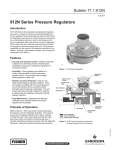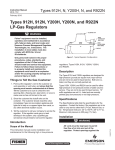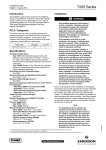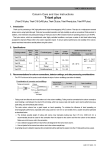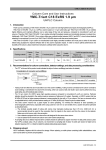Download Emerson 912 Series Pressure Reducing Regulators for LP-Gas Service Instruction Manual
Transcript
Type 912N-HNRUL Instruction Manual MCK-2286 July 2010 Type 912N-HNRUL Compressed Gas Non-Relief Pressure Regulator ! Warning Failure to follow these instructions or to properly install and maintain this equipment could result in an explosion, fire and/or chemical contamination causing property damage and personal injury or death. Fisher® regulators must be installed, operated, and maintained in accordance with federal, state, and local codes, rules and regulations, and Emerson Process Management Regulator Technologies, Inc. instructions. For LP-Gas service, an approved regulator (such as one listed by UL) should be used or approved by the Authority Having Jurisdiction. Figure 1. Type 912N-HNRUL Regulator If the regulator vents gas or a leak develops in the system, service to the unit may be required. Failure to correct trouble could result in a hazardous condition. Call a gas service person to service the unit. Only a qualified person must install or service the regulator. Description The Type 912N-HNRUL is a compressed gas pressure regulator with the following features: non-adjustable pressure setting, no-internal relief, direct-operated, and spring-loaded. The regulator is built to provide accurate and sensitive control suited to a variety of applications. Introduction The Type 912N-HNRUL is UL listed as a Compressed Gas Regulator for Hydrogen service. Scope of the Manual Specifications Specifications for the Type 912N-HNRUL compressed gas non-relief regulator are given on page 2. D450223T012 This manual provides installation, maintenance and parts ordering information for the Type 912N-HNRUL non-relief pressure regulator (Figure 1) as used in compressed gas applications. www.fisherregulators.com Type 912N-HNRUL Specifications Body Sizes and End Connection Style Inlet: 1/4-inch NPT Outlet: 3/8-inch NPT Maximum Allowable Inlet Pressure(1) 250 psig (17,2 bar) Orifice Size 0.073-inch (1,9 mm) Outlet Pressure Standard Setpoint(1) 14-inches w.c. (35 mbar) Non-Adjustable Non-Relief Performance Sealing valve and closing cap can maintain 20 psig (1,4 bar) pressure Maximum Allowable Outlet Pressure(1) Emergency Outlet Pressure: 20 psig (1,4 bar) Recommended Outlet Pressure to Avoid Internal Part Damage: 3 psi (0,21 bar differential) above outlet pressure setting Temperature Capabilities(1) -20° to 160°F (-29° to 71°C) Pressure Registration Internal Vent Size 1/8-inch NPT (standard) Approximate Weight 1.30 pounds (0,6 kg) 1. The pressure/temperature limits in this Instruction Manual or any applicable standard limitation should not be exceeded. Principle of Operation Inlet pressure flows through the open orifice into the regulator body and pressurizes the cavity formed by the body and diaphragm assembly. When downstream demand is reduced, the pressure under the diaphragm increases. This pressure overcomes the regulator setting (which is set by a spring) and moves the diaphragm assembly upwards. This upward motion is transferred to the lever which in turn closes the disc holder/disc against the orifice and reduces gas flow. If a higher volume flow rate is demanded downstream, the pressure under the diaphragm decreases. The control spring force pushes the diaphragm assembly downward, lifting the lever which moves the valve disc away from the orifice allowing more gas into the downstream piping. Installation ! Warning Personal injury or equipment damage may result if the regulator is installed where service conditions could exceed the pressure or temperature specifications in Specifications section. The regulator must not be used for hazardous gas service in a closed area 2 unless the vent is piped to a safe area. The vent opening on the regulator or the opening on the remote vent pipe (if one is used) should be pointed down to minimize clogging from collected moisture, corrosive chemicals, and other foreign material. Overpressuring the downstream system (and risk of explosion) could result from a clogged vent. Overpressuring any portion of a regulator or associated equipment may cause leakage, part damage, or personal injury due to bursting of pressure-containing parts or explosion of accumulated gas. The Type 912N-HNRUL regulator has an outlet pressure rating lower than the inlet pressure rating. Downstream protection is required if the actual inlet pressure can exceed the regulator outlet pressure rating or the pressure rating of any downstream equipment. Regulator operation within ratings does not preclude the possibility of damage from external sources or from debris in the lines. A regulator should be inspected for damage periodically and after any overpressure condition. Ensure that the regulator is undamaged and contains no foreign material. Install the regulator so that the flow through it leaves the outlet port (marked on the Type 912N-HNRUL body). The regulator may be installed in any position. However, the spring case vent should be pointed down. Spring case/vent orientation can be changed by rotating the spring case with respect to the body. For an indoor installation, if the regulator controls a gas that is flammable or otherwise hazardous, a spring case with the standard vent line should be used so that the exhaust can be piped away. Provide protection on a remote vent by installing a screened vent cap into the remote end of the vent pipe. The vent should be pointed down. Maintenance Regulator parts are subject to normal wear and must be inspected and replaced as necessary. The frequency of inspection depends on the severity of service conditions or the requirements of local, state, and federal rules and regulations. To avoid personal injury or equipment damage, do not attempt any maintenance or disassembly without first isolating the regulator from system pressure and relieving all internal pressure from the regulator. Apply a good grade of pipe compound to the pipe threads before making the connections. Install piping into the 1/4-inch NPT inlet connection and the 3/8-inch NPT outlet connection. Startup Warning ! Parts List Key numbers are referenced in Figures 2 and 3. Key Description With installation completed and downstream equipment properly adjusted, slowly open the upstream and downstream shutoff valves while monitoring the regulator output pressure. 1 Note The Type 912N-HNRUL has an adjusting screw that is applied with a permanent bond. ! Warning For the Type 912N-HNRUL construction never adjust the control spring to produce an outlet pressure higher than the outlet pressure range for that particular spring. Doing so could overpressure the system and cause personal injury or equipment damage. Body, Zinc 1/4 x 3/8-inch NPT 2 Spring Case 3 Closing Cap 4 Adjusting Screw 5 Regulator Spring, Steel 10 Diaphragm Plate, Zinc-plated Steel 11 Disc Holder 12 Fulcrum Rod, 302 Stainless steel 13 Machine Screw, Steel (2 required) 14 Machine Screw, Steel (6 required) 15 Diaphragm, Nitrile (NBR) Spring Range: 12 to 24-inches w.c. (30 to 60 mbar) 16 Vent Screen, 304 Stainless steel 29 Disc, Fluorocarbon (FKM) 30 O-ring, Nitrile 31 Lock Nut, Zinc-plated Steel 32 Lock Washer, Plated Carbon Steel 33 Flat Washer, Steel Shutdown 36 Pusher post, Aluminum Close the nearest upstream shutoff valve, then close the nearest downstream shutoff valve. Vent pressure from the outlet of the regulator. 3 Type 912N-HNRUL PB 4 3 2 30 32 5 33 31 16 10 1/8-inch NPT L 14 13 23 top view 15 21 4 3 2 30 32 5 33 GE34610 10 16 1 36 11 12 29 14 13 Apply lubricant (L) or permanent bond (PB) as described 15 Figure 2. Type 912N-HNRUL Non-Relief Pressure Regulator Assembly 31 15 32 1 31 11 12 29 33 10 GE35806 36 Figure 3. Type 912N-HNRUL Diaphragm Assembly LP-Gas Equipment Emerson Process Management Regulator Technologies, Inc. USA - Headquarters McKinney, Texas 75069-1872 USA Telephone: 1 (800) 558-5853 Telephone: 1 (972) 548-3574 For further information visit www.fisherregulators.com The Emerson logo is a trademark and service mark of Emerson Electric Co. All other marks are the property of their prospective owners. Fisher is a mark owned by Fisher Controls, Inc., a business of Emerson Process Management. The contents of this publication are presented for informational purposes only, and while every effort has been made to ensure their accuracy, they are not to be construed as warranties or guarantees, express or implied, regarding the products or services described herein or their use or applicability. We reserve the right to modify or improve the designs or specifications of such products at any time without notice. Emerson Process Management does not assume responsibility for the selection, use or maintenance of any product. Responsibility for proper selection, use and maintenance of any Emerson Process Management product remains solely with the purchaser. ©Emerson Process Management Regulator Technologies, Inc., 2009, 2010; All Rights Reserved




